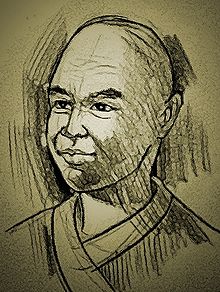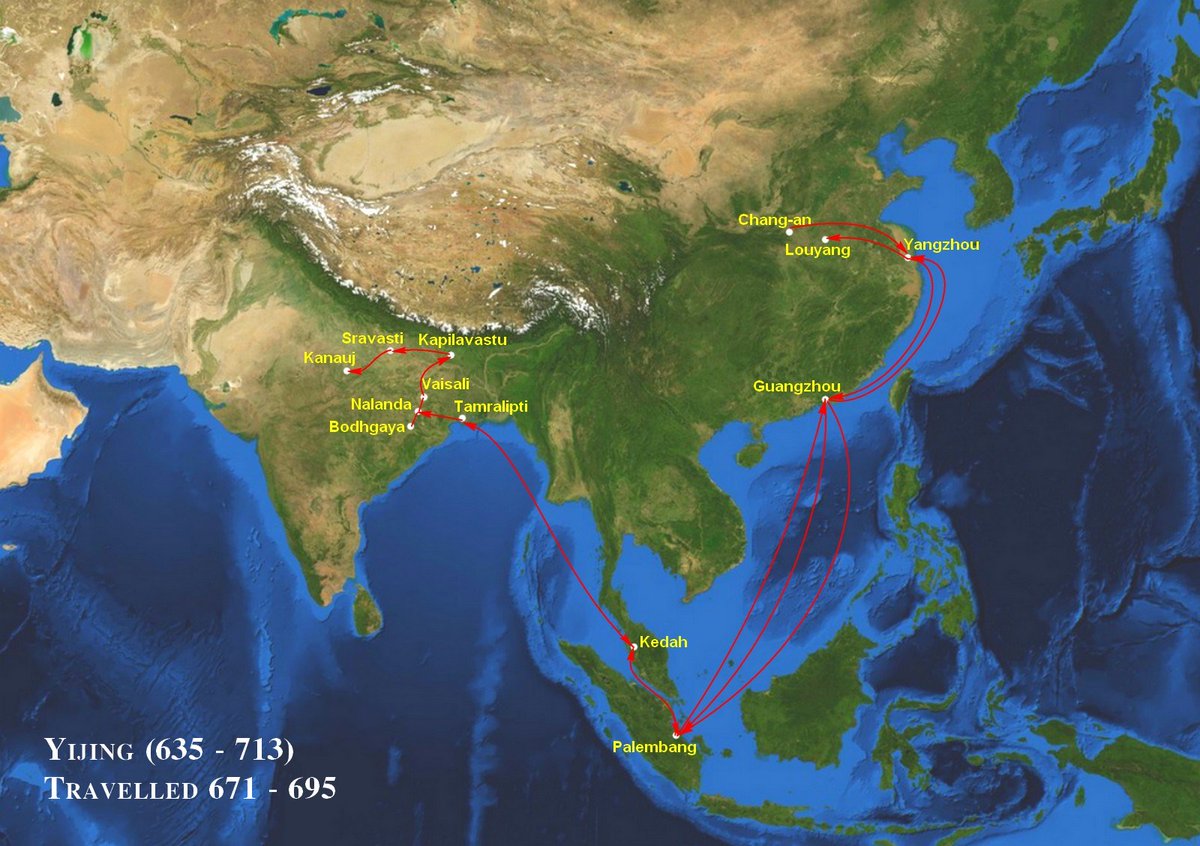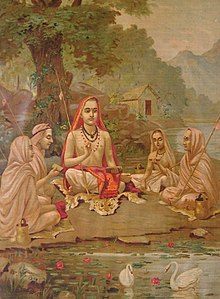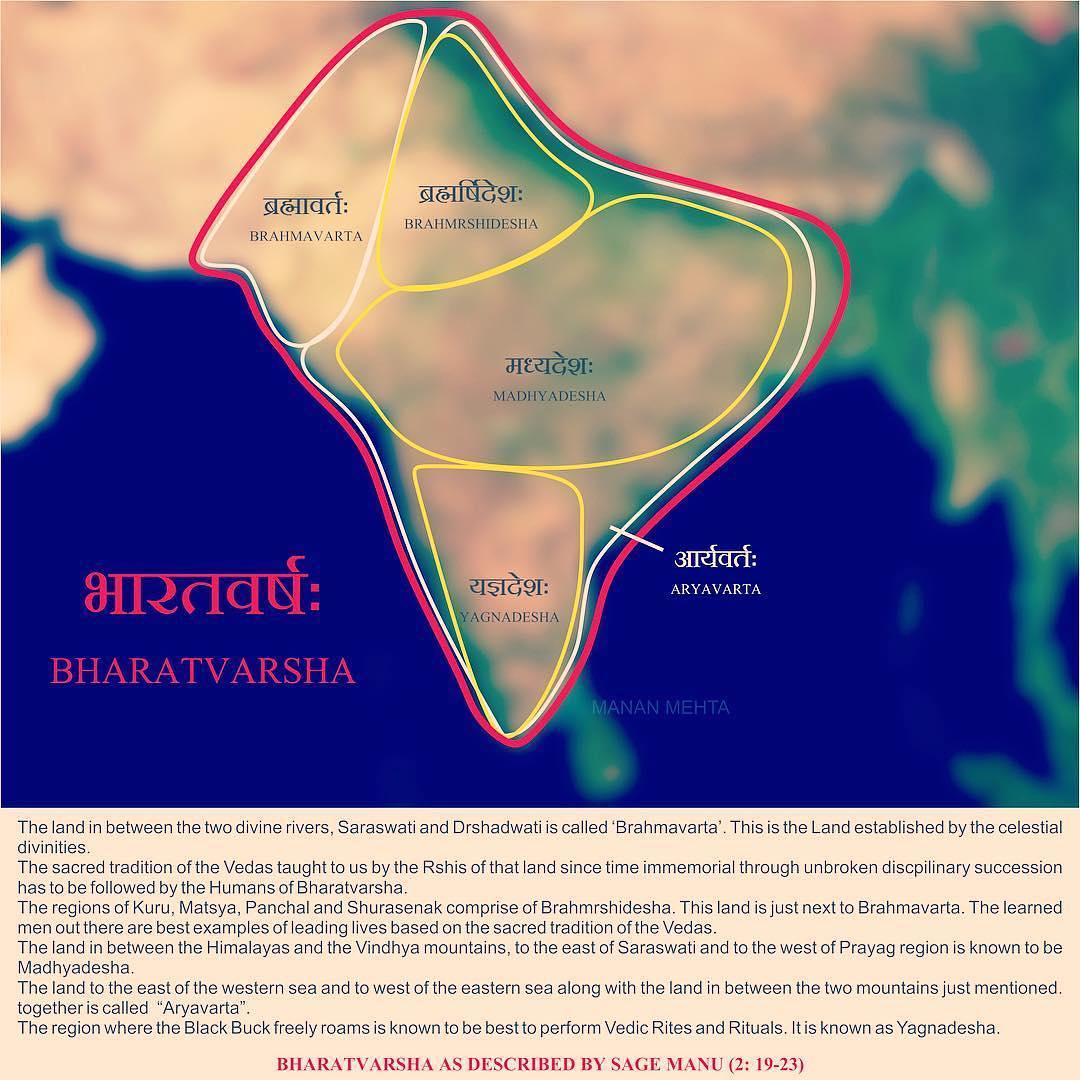Chapter 8: Observations of Yijing on Indian Education in the late 7th century AD
After about 30 years of Xuanzang's visit, another Chinese monk named Yijing or I-tsing visited India and has left an imprint on India's education system.
After about 30 years of Xuanzang's visit, another Chinese monk named Yijing or I-tsing visited India and has left an imprint on India's education system.
I-tsing visited India between 673-695 AD, just 28 years after Xuanzang left India.
I-tsing's record about India misses the wealth of details which made Xuanzang's account so famous. And yet, the account of I-tsing forms an important addition to the works of Xuanzang.
I-tsing's record about India misses the wealth of details which made Xuanzang's account so famous. And yet, the account of I-tsing forms an important addition to the works of Xuanzang.
Reverence of I-tsing for Xuanzang
Xuanzang exercised a considerable personal influence upon I-tsing. According to his biographer, He calls Xuanzang " the Tripitaka teacher of China."
He also was an eyewitness to Xuanzang's funeral which was organized by the Tang Emperor.
.
Xuanzang exercised a considerable personal influence upon I-tsing. According to his biographer, He calls Xuanzang " the Tripitaka teacher of China."
He also was an eyewitness to Xuanzang's funeral which was organized by the Tang Emperor.
.
I-tsing was also impressed very much with Fa-Hien, in whose footsteps he followed in order to drink from that fountain of knowledge called India.
Object of I-tsing's mission & its Difficulties
Like Fa-Hien, I-tsing's objective was also to gather the sacred Buddhist texts so as to correct its misrepresentations in China.
Like Fa-Hien, I-tsing's objective was also to gather the sacred Buddhist texts so as to correct its misrepresentations in China.
At first, he organized a band of scholars to undertake the mission.
But eventually, he had to travel almost alone , his companion being a youthful priest.
Not discouraged, he had the inspiring words of his teacher to lead him and go on a long journey:
But eventually, he had to travel almost alone , his companion being a youthful priest.
Not discouraged, he had the inspiring words of his teacher to lead him and go on a long journey:
" Go without hesitation and don't look back. I approve of your pilgrimage to the holy places. Moreover it is more important to strive for prosperity of religion. Rest clear from doubt ! This is a great opportunity for you which will not occur twice."
Places Visited by I-tsing
The places visited by I-tsing was much fewer than Xuanzang. He visited Kapilvastu, Nalanda, Vaishali, Kusinagara, Rājagriha, Benaras & Tamralipti.
He stayed for four months at Tamralipti and 10 years at Nalanda.
The places visited by I-tsing was much fewer than Xuanzang. He visited Kapilvastu, Nalanda, Vaishali, Kusinagara, Rājagriha, Benaras & Tamralipti.
He stayed for four months at Tamralipti and 10 years at Nalanda.
He refers to several other places like Lāta, Kashmir, Nepal, Sindhu, Valabhi. But these descriptions are not of an eyewitness.
I-tsing says: " Although, I myself did not see all these places, I could nevertheless ascertain everything by careful inquiry."
I-tsing says: " Although, I myself did not see all these places, I could nevertheless ascertain everything by careful inquiry."
Strength of Hinduism
The predominance of Hinduism over Buddhism continued in I-tsing's time.
India was known in his times as ' Brahma-rashtra'. Sanskrit was called 'Brahma language ' and was used even by the Buddhist monks.
The predominance of Hinduism over Buddhism continued in I-tsing's time.
India was known in his times as ' Brahma-rashtra'. Sanskrit was called 'Brahma language ' and was used even by the Buddhist monks.
I-tsing mentions 96 non-Buddhist sects & mentions the Samkhya & Vaiseshika systems of philosophy.
Some of the existing sects of the times are described thus:
" Some think it necessary, in order to get rid of rebirth, to go naked & hair plucked out".
Some of the existing sects of the times are described thus:
" Some think it necessary, in order to get rid of rebirth, to go naked & hair plucked out".
" Some insist on covering their bodies with ash, & tying up their locks of hair ; some say life is self-existent ; there are many who think existence is a mystery, too complicated for us to know whence we have come into being."
I-tsing also refers to Brahmins as being regarded throughout five parts of India the " most honourable caste.
He says: " The scriptures they rever are the four Vedas containing more than 100,000 verses, which have been handed down orally, not written on paper or leaves."
He says: " The scriptures they rever are the four Vedas containing more than 100,000 verses, which have been handed down orally, not written on paper or leaves."
"In every generation there exist some intelligent Brahmins, who can recite all verses."
"In India there are 2 methods of learning: one is to repeatedly committing to memory, secondly alphabet fixes one's ideas". After months of learning, pupil can memorize what has been learnt."
"In India there are 2 methods of learning: one is to repeatedly committing to memory, secondly alphabet fixes one's ideas". After months of learning, pupil can memorize what has been learnt."
Elementary Education Observed by I-tsing
Like Xuanzang, I-tsing gives an account of elementary education of the times.
Education began at the age of 6 years.
Like Xuanzang, I-tsing gives an account of elementary education of the times.
Education began at the age of 6 years.
The first book of reading is 'Siddhirastu' which gives 49 letters of the alphabet & 10,000 syllables arranged in 300 slokas. This book was finished in 6 months.
The second book of reading is the sūtra of Panini, containing 1000 slokas which the children " begin to learn when they are eight years old & can repeat it in eight months time."
Next followed the book on Dhātu & on ' khilas' which boys would begin at 10 yrs & finish in 3 yrs.
Next followed the book on Dhātu & on ' khilas' which boys would begin at 10 yrs & finish in 3 yrs.
The next book to read is the famous ' kāsikāvritti', " the best" of all the commentaries on Panini's sūtra comprising 18,000 slokas & composed by the learned Jayāditya , " a man of great ability with very striking literary power" who died 30 years before I-tsing.
I-tsing says: " Boys of 15 years begin to study this commentary & understand it after years. If men from China go to India, they must first learn this, then other subjects ; if not their labour will be thrown away."
Medical Sciences
I-tsing mentions an interesting description of 8 stages of Ayurveda.
These 8 divisions of Ayurvedic treatment are :
1) sores, inward & outward
2) Diseases above the neck
I-tsing mentions an interesting description of 8 stages of Ayurveda.
These 8 divisions of Ayurvedic treatment are :
1) sores, inward & outward
2) Diseases above the neck
3) Disease of the body
4) demonic diseases due to attack of evil spirits
5) antidotes to poison
6) Diseases of children from embryo stage to the 16th year
7) the means of lengthening life, &
8) The method of invigorating the legs & body.
4) demonic diseases due to attack of evil spirits
5) antidotes to poison
6) Diseases of children from embryo stage to the 16th year
7) the means of lengthening life, &
8) The method of invigorating the legs & body.
Unsuccessful Teachers & Pupils
Not all teachers or pupils in monasteries were successful. The monks unable to understand the Vinaya and thus " compelled to live under another's care during the whole of their lifetime."
Not all teachers or pupils in monasteries were successful. The monks unable to understand the Vinaya and thus " compelled to live under another's care during the whole of their lifetime."
Sometimes the failure may be due to want of a good teacher. " If there be no good teacher, he must live under the care of a sub-teacher." Says I-tsing.
From a sub-teacher he may receive the instructions twice in the mornings & evenings.
The incapacity of a teacher is condemned in the Vinaya texts:
" Rather be a butcher than a priest who gives others full ordination & leaves them untaught."
The incapacity of a teacher is condemned in the Vinaya texts:
" Rather be a butcher than a priest who gives others full ordination & leaves them untaught."
Unsuccessful Monasteries
There were unsuccessful monasteries as well.
I-tsing speaks of some monasteries giving themselves up wholly to " unlawful life" violating the prime injunctions of the Vinaya texts.
There were unsuccessful monasteries as well.
I-tsing speaks of some monasteries giving themselves up wholly to " unlawful life" violating the prime injunctions of the Vinaya texts.
Successful Monasteries & their best Products
As regards their successes, the monasteries produced some of the highest types of intellect & character. One of their principal aims was to produce preachers.
As regards their successes, the monasteries produced some of the highest types of intellect & character. One of their principal aims was to produce preachers.
Such persons were needed to propagate their religion & to maintain its position against numerous non-Buddhist sects present in India in those days.
Accordingly, the highest honour in the Buddhist world of scholarship was accorded to those who would " oppose the heretics, as "they would drive beasts in the middle of the plain & explain away disputation as boiling water melts frost."
Men of such reputation are, of course rare, " only one or two appearing in every generation."
I-tsing mentions some of these great teachers belonging to different periods of Buddhist history "such as Nāgārjuna, Deva, Asvaghosa, Gunmati, Dharmakirti, Samghabhadra".
I-tsing mentions some of these great teachers belonging to different periods of Buddhist history "such as Nāgārjuna, Deva, Asvaghosa, Gunmati, Dharmakirti, Samghabhadra".
The institutions successful in producing this type of intellect were Nālānda and Vallabhi.
The friction of best minds that collected at these two famous centres of learning was the best means of developing & sharpening the wits and powers of debate.
The friction of best minds that collected at these two famous centres of learning was the best means of developing & sharpening the wits and powers of debate.
Literary Celebrities of the Times
I-tsing refers to these literary celebrities as either his contemporaries or personal acquaintances who were alive between 670-700 AD.
I-tsing refers to these literary celebrities as either his contemporaries or personal acquaintances who were alive between 670-700 AD.
I-tsing says: " Jnānāchandra, the master of law who lives in Magadha ; Ratamsimha, who lives at Nālānda , Divākarmitra, who lives in Eastern India & Sākyakrit in Southern India, who has travelled all over India."
All these men, says I-tsing, " were renowned for their character as much as their knowledge. In discourse they follow Nāgārjuna and in philosophical exposition they followed Samghabhadra."
I-tsing continues: "I used to converse with these teachers so intimately that I was able to receive invaluable instructions from them. I have always been very glad that I had the opportunity acquiring knowledge from them personally, which I should otherwise never have possessed."
Cultural Exchanges between India & China
In conclusion, it can be noted that at time of I-tsing's visit to India, there was no interruption of Chinese scholars visiting India to learn & of Indian scholars to China to spread their wisdom.
In conclusion, it can be noted that at time of I-tsing's visit to India, there was no interruption of Chinese scholars visiting India to learn & of Indian scholars to China to spread their wisdom.

 Read on Twitter
Read on Twitter





